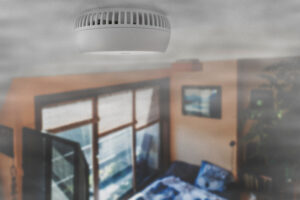
Letting out a property is a very worthwhile undertaking and can be very rewarding, but it doesn’t come without responsibility. As a landlord, the safety of your tenants is and always will be your top priority. In this article we will take you through your safety responsibilities and the legal framework around them. This article will focus on the rules and regulations in England, they do differ for Scotland, Wales and Northern Ireland.

Smoke and Carbon Monoxide
Under the Smoke and Carbon Monoxide Alarm (England) Regulations 2015, at least 1 smoke detector must be installed on every floor of the property where at least 1 room is fully or partially used for living accommodation. There should also be a carbon monoxide alarm in any room where solid fuel such as wood or coal is burnt.
It is the landlord’s responsibility to ensure that the alarms are working on the first day of the tenancy.
Electrical safety
The Electrical Safety standards in the private rented sector (England) Regulations 2020 set out the requirements for Electrical safety in privately rented accommodation. These Regulations have been in force since April 2021 for all tenancies. The Landlord has to ensure that all fixed electrical installations are safe and maintained properly. This includes the fuse board, switches, sockets and light fittings. The Regulations require the landlord to have a safety inspection carried out by a qualified electrician at intervals of no more than 5 years.
Gas Safety
The Gas Safety (Installation and Use) Regulations 1998 as amended in 2018 outline what a landlord’s responsibilities are with regards to ensuring that all gas appliances, fittings, flues and chimneys are safe. A landlord must ensure that all gas appliances and flues are checked annually by a gas safe registered engineer. The Landlord also needs to supply a copy of the Landlord Gas Safety Record to the tenant for information.
Legionella
Legionella is caused by the inhalation of the bacteria that causes it from small droplets of water. The control of Legionella is governed under the Health and Safety at work Act 1974, the Control of Substances Hazardous the Health Regulations 2002 and the L8 Approved Code of Practice, all of which falls under the remit of the Health and Safety Executive (HSE). According to the HSE a Landlord should:
- Complete a Risk Assessment
- Flush out the water system prior to letting the property
- avoid debris getting into the system (eg ensure the cold water tanks, where fitted, have a tight fitting lid)
- set control parameters (eg, setting the temperature of the hot water cylinder (calorifier) to ensure water is stored at 60°C)
- make sure any redundant pipework identified is removed.
Furniture and Furnishings
Under the Furniture and Furnishings (Fire) (Safety) Regulations 1988 as amended 1993 and 2010, any furniture or furnishings supplied by a landlord must have set levels of fire resistance and have an appropriate label to that effect. If supplied furniture such as mattresses and sofas do not conform or do not have a label they should be replaced.
Being a landlord is a responsible job and ensuring that the property that is being rented out is safe, is the number one priority for all good landlords.



